Risk Management Strategies and Analysis for MacVille Coffee Company
VerifiedAdded on 2022/08/19
|17
|2418
|10
Report
AI Summary
This report provides a comprehensive analysis of the risk management practices of MacVille, an Australian coffee supplier. The report examines the company's business operations, including its adoption of Triple Bottom Line (TBL) principles and Enterprise Risk Management (ERM) policies. It identifies key risks, such as revenue risks stemming from competition and changing customer preferences, environmental risks related to compliance and sustainability, and supply chain risks associated with coffee scarcity. The report analyzes the likelihood and consequences of these risks and proposes control measures. It highlights the importance of stakeholder consultation, including management, employees, and suppliers, in risk evaluation and analysis. The report also outlines the required resources, compliance with relevant legislations and standards, and the tools and skills used in risk identification and analysis. Furthermore, it details the procedures for implementing and communicating the risk management plan, including training and documentation. The report concludes with a discussion of audit processes and continuous improvement in risk management, emphasizing the importance of a proactive and comprehensive approach.
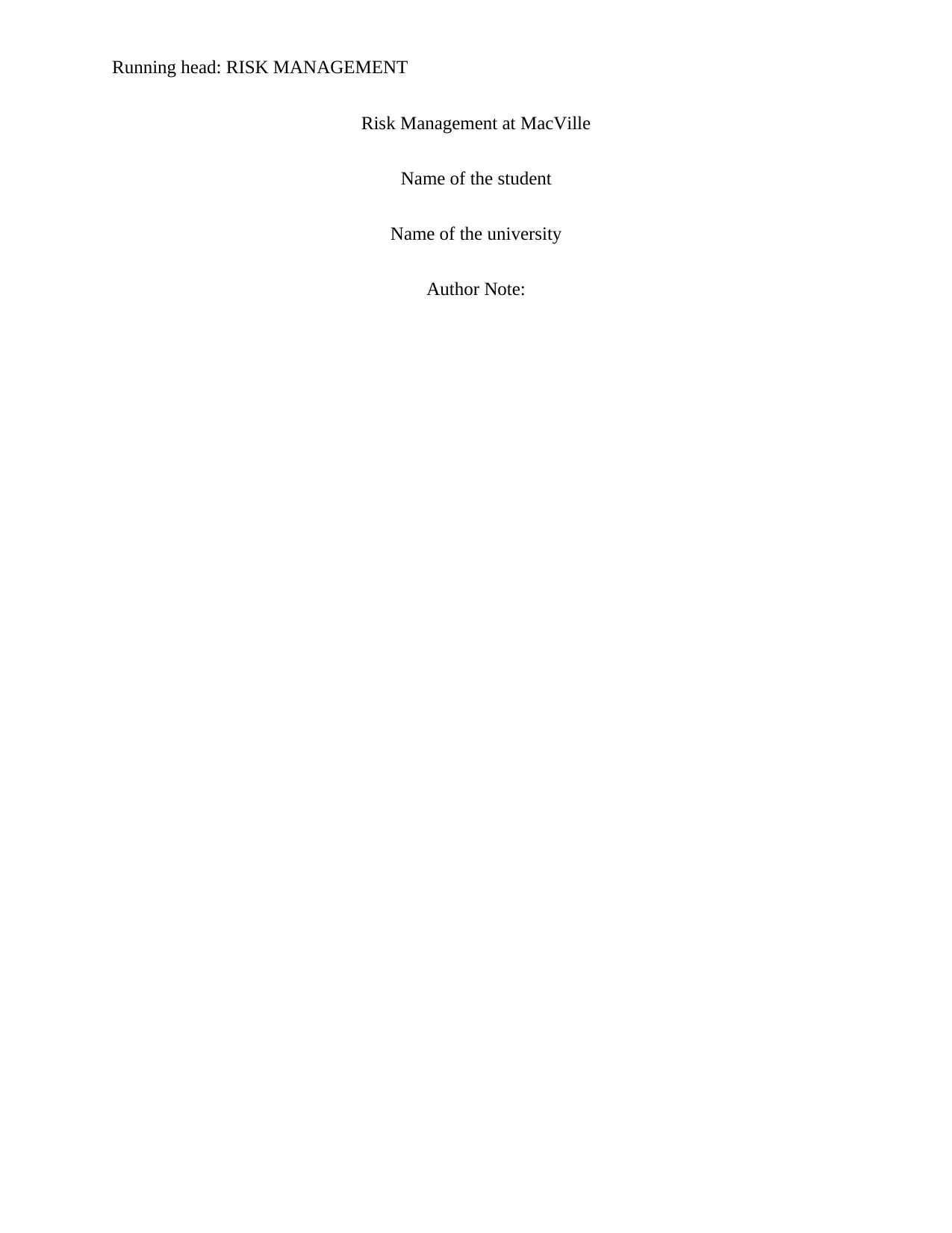
Running head: RISK MANAGEMENT
Risk Management at MacVille
Name of the student
Name of the university
Author Note:
Risk Management at MacVille
Name of the student
Name of the university
Author Note:
Paraphrase This Document
Need a fresh take? Get an instant paraphrase of this document with our AI Paraphraser
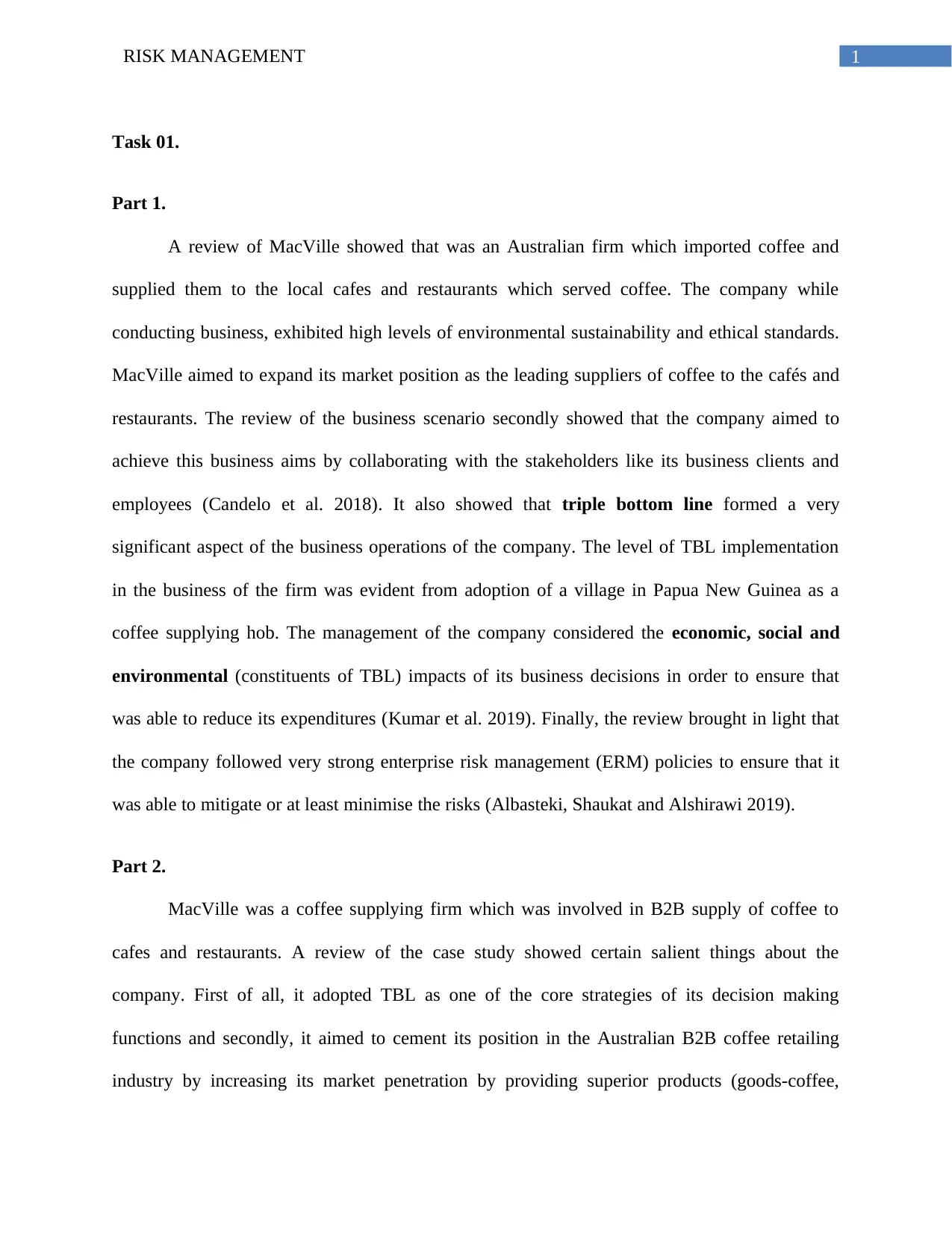
1RISK MANAGEMENT
Task 01.
Part 1.
A review of MacVille showed that was an Australian firm which imported coffee and
supplied them to the local cafes and restaurants which served coffee. The company while
conducting business, exhibited high levels of environmental sustainability and ethical standards.
MacVille aimed to expand its market position as the leading suppliers of coffee to the cafés and
restaurants. The review of the business scenario secondly showed that the company aimed to
achieve this business aims by collaborating with the stakeholders like its business clients and
employees (Candelo et al. 2018). It also showed that triple bottom line formed a very
significant aspect of the business operations of the company. The level of TBL implementation
in the business of the firm was evident from adoption of a village in Papua New Guinea as a
coffee supplying hob. The management of the company considered the economic, social and
environmental (constituents of TBL) impacts of its business decisions in order to ensure that
was able to reduce its expenditures (Kumar et al. 2019). Finally, the review brought in light that
the company followed very strong enterprise risk management (ERM) policies to ensure that it
was able to mitigate or at least minimise the risks (Albasteki, Shaukat and Alshirawi 2019).
Part 2.
MacVille was a coffee supplying firm which was involved in B2B supply of coffee to
cafes and restaurants. A review of the case study showed certain salient things about the
company. First of all, it adopted TBL as one of the core strategies of its decision making
functions and secondly, it aimed to cement its position in the Australian B2B coffee retailing
industry by increasing its market penetration by providing superior products (goods-coffee,
Task 01.
Part 1.
A review of MacVille showed that was an Australian firm which imported coffee and
supplied them to the local cafes and restaurants which served coffee. The company while
conducting business, exhibited high levels of environmental sustainability and ethical standards.
MacVille aimed to expand its market position as the leading suppliers of coffee to the cafés and
restaurants. The review of the business scenario secondly showed that the company aimed to
achieve this business aims by collaborating with the stakeholders like its business clients and
employees (Candelo et al. 2018). It also showed that triple bottom line formed a very
significant aspect of the business operations of the company. The level of TBL implementation
in the business of the firm was evident from adoption of a village in Papua New Guinea as a
coffee supplying hob. The management of the company considered the economic, social and
environmental (constituents of TBL) impacts of its business decisions in order to ensure that
was able to reduce its expenditures (Kumar et al. 2019). Finally, the review brought in light that
the company followed very strong enterprise risk management (ERM) policies to ensure that it
was able to mitigate or at least minimise the risks (Albasteki, Shaukat and Alshirawi 2019).
Part 2.
MacVille was a coffee supplying firm which was involved in B2B supply of coffee to
cafes and restaurants. A review of the case study showed certain salient things about the
company. First of all, it adopted TBL as one of the core strategies of its decision making
functions and secondly, it aimed to cement its position in the Australian B2B coffee retailing
industry by increasing its market penetration by providing superior products (goods-coffee,
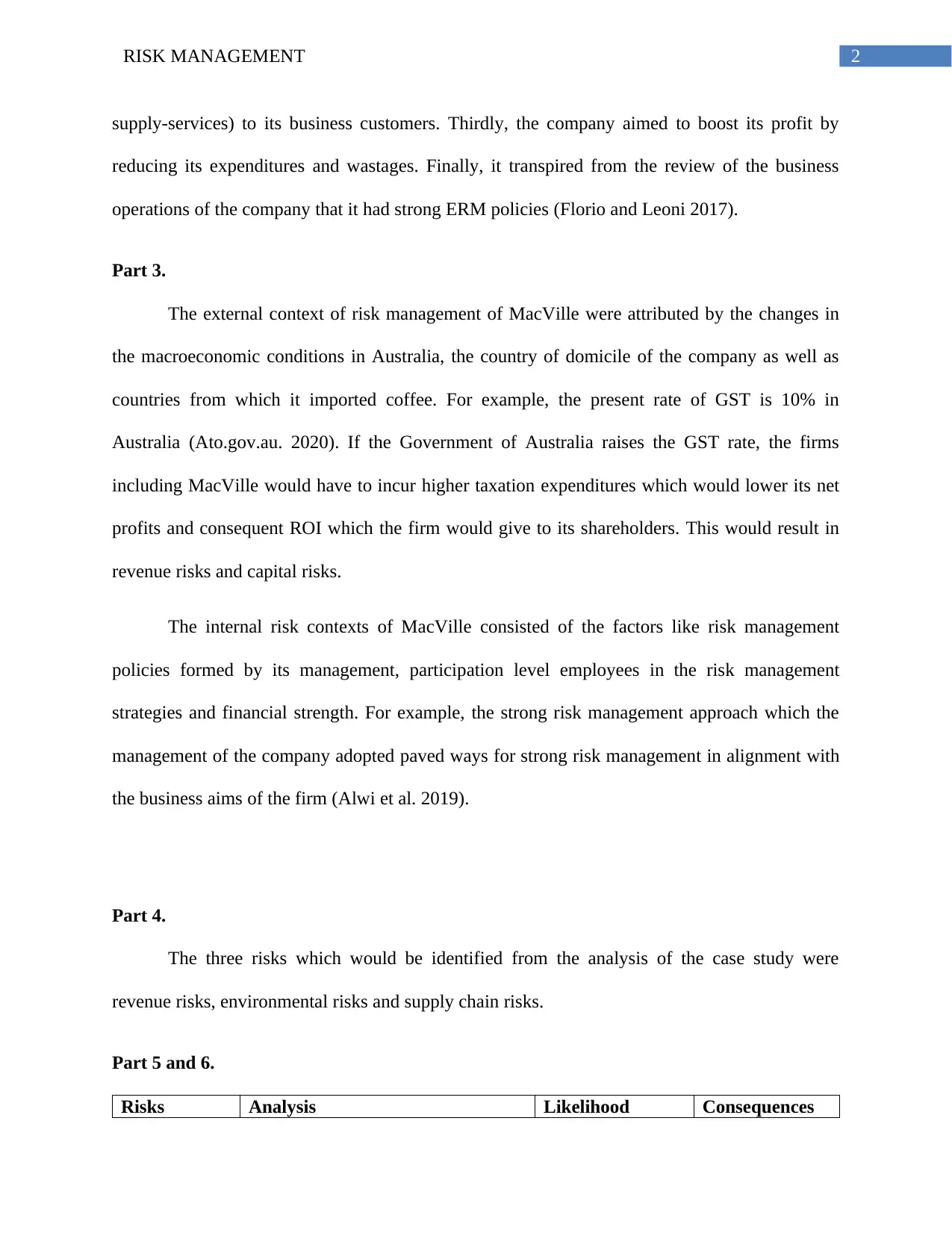
2RISK MANAGEMENT
supply-services) to its business customers. Thirdly, the company aimed to boost its profit by
reducing its expenditures and wastages. Finally, it transpired from the review of the business
operations of the company that it had strong ERM policies (Florio and Leoni 2017).
Part 3.
The external context of risk management of MacVille were attributed by the changes in
the macroeconomic conditions in Australia, the country of domicile of the company as well as
countries from which it imported coffee. For example, the present rate of GST is 10% in
Australia (Ato.gov.au. 2020). If the Government of Australia raises the GST rate, the firms
including MacVille would have to incur higher taxation expenditures which would lower its net
profits and consequent ROI which the firm would give to its shareholders. This would result in
revenue risks and capital risks.
The internal risk contexts of MacVille consisted of the factors like risk management
policies formed by its management, participation level employees in the risk management
strategies and financial strength. For example, the strong risk management approach which the
management of the company adopted paved ways for strong risk management in alignment with
the business aims of the firm (Alwi et al. 2019).
Part 4.
The three risks which would be identified from the analysis of the case study were
revenue risks, environmental risks and supply chain risks.
Part 5 and 6.
Risks Analysis Likelihood Consequences
supply-services) to its business customers. Thirdly, the company aimed to boost its profit by
reducing its expenditures and wastages. Finally, it transpired from the review of the business
operations of the company that it had strong ERM policies (Florio and Leoni 2017).
Part 3.
The external context of risk management of MacVille were attributed by the changes in
the macroeconomic conditions in Australia, the country of domicile of the company as well as
countries from which it imported coffee. For example, the present rate of GST is 10% in
Australia (Ato.gov.au. 2020). If the Government of Australia raises the GST rate, the firms
including MacVille would have to incur higher taxation expenditures which would lower its net
profits and consequent ROI which the firm would give to its shareholders. This would result in
revenue risks and capital risks.
The internal risk contexts of MacVille consisted of the factors like risk management
policies formed by its management, participation level employees in the risk management
strategies and financial strength. For example, the strong risk management approach which the
management of the company adopted paved ways for strong risk management in alignment with
the business aims of the firm (Alwi et al. 2019).
Part 4.
The three risks which would be identified from the analysis of the case study were
revenue risks, environmental risks and supply chain risks.
Part 5 and 6.
Risks Analysis Likelihood Consequences
⊘ This is a preview!⊘
Do you want full access?
Subscribe today to unlock all pages.

Trusted by 1+ million students worldwide
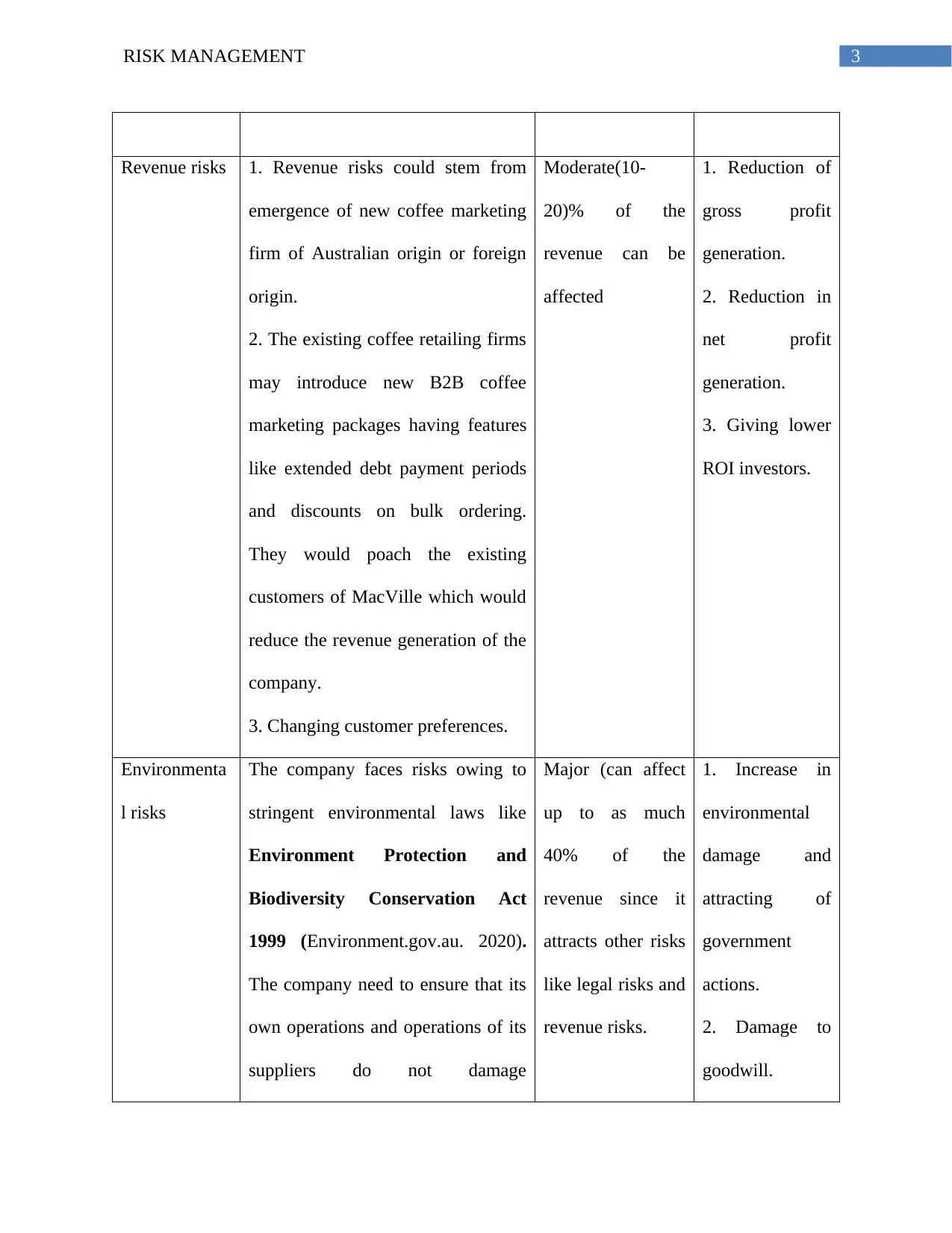
3RISK MANAGEMENT
Revenue risks 1. Revenue risks could stem from
emergence of new coffee marketing
firm of Australian origin or foreign
origin.
2. The existing coffee retailing firms
may introduce new B2B coffee
marketing packages having features
like extended debt payment periods
and discounts on bulk ordering.
They would poach the existing
customers of MacVille which would
reduce the revenue generation of the
company.
3. Changing customer preferences.
Moderate(10-
20)% of the
revenue can be
affected
1. Reduction of
gross profit
generation.
2. Reduction in
net profit
generation.
3. Giving lower
ROI investors.
Environmenta
l risks
The company faces risks owing to
stringent environmental laws like
Environment Protection and
Biodiversity Conservation Act
1999 (Environment.gov.au. 2020).
The company need to ensure that its
own operations and operations of its
suppliers do not damage
Major (can affect
up to as much
40% of the
revenue since it
attracts other risks
like legal risks and
revenue risks.
1. Increase in
environmental
damage and
attracting of
government
actions.
2. Damage to
goodwill.
Revenue risks 1. Revenue risks could stem from
emergence of new coffee marketing
firm of Australian origin or foreign
origin.
2. The existing coffee retailing firms
may introduce new B2B coffee
marketing packages having features
like extended debt payment periods
and discounts on bulk ordering.
They would poach the existing
customers of MacVille which would
reduce the revenue generation of the
company.
3. Changing customer preferences.
Moderate(10-
20)% of the
revenue can be
affected
1. Reduction of
gross profit
generation.
2. Reduction in
net profit
generation.
3. Giving lower
ROI investors.
Environmenta
l risks
The company faces risks owing to
stringent environmental laws like
Environment Protection and
Biodiversity Conservation Act
1999 (Environment.gov.au. 2020).
The company need to ensure that its
own operations and operations of its
suppliers do not damage
Major (can affect
up to as much
40% of the
revenue since it
attracts other risks
like legal risks and
revenue risks.
1. Increase in
environmental
damage and
attracting of
government
actions.
2. Damage to
goodwill.
Paraphrase This Document
Need a fresh take? Get an instant paraphrase of this document with our AI Paraphraser
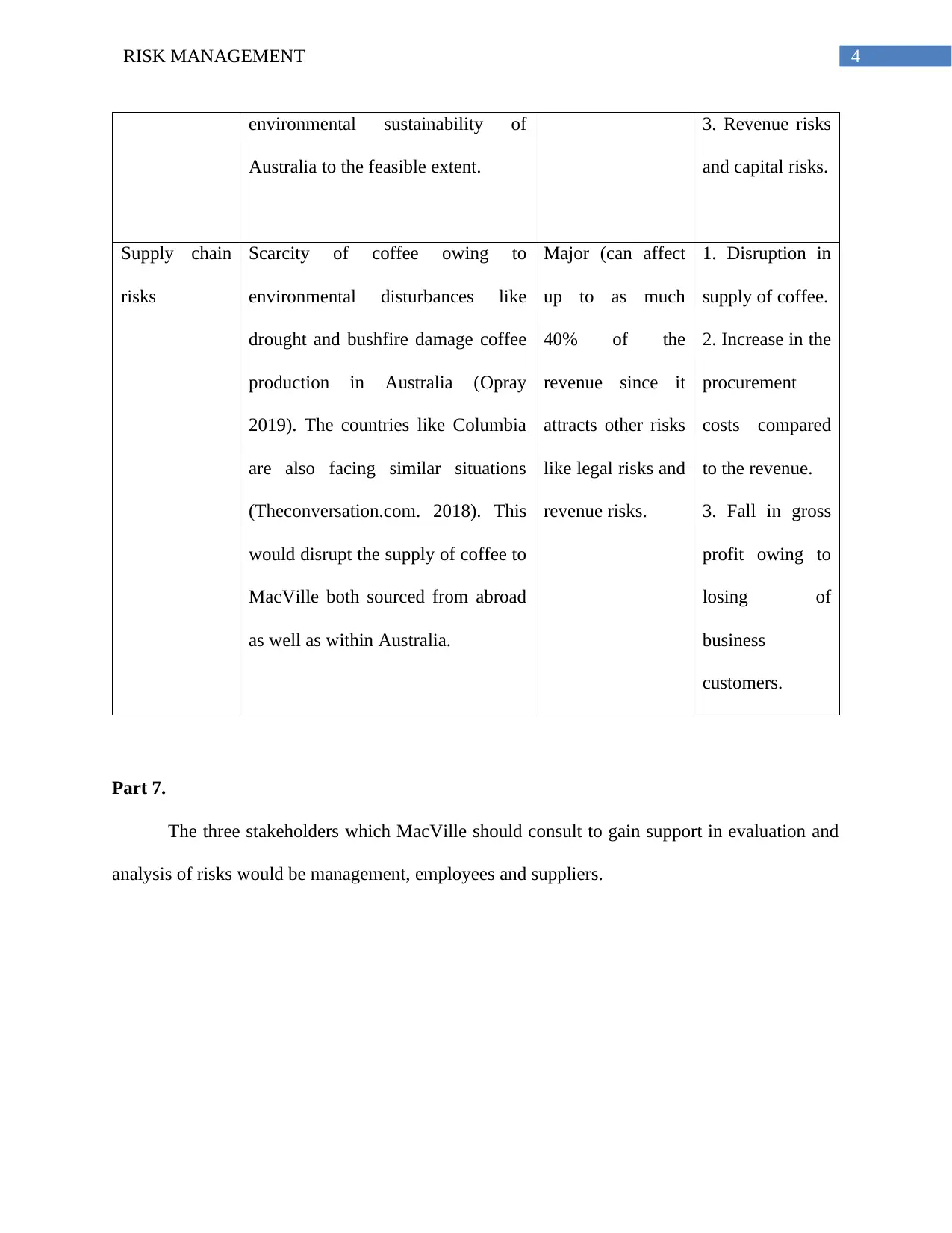
4RISK MANAGEMENT
environmental sustainability of
Australia to the feasible extent.
3. Revenue risks
and capital risks.
Supply chain
risks
Scarcity of coffee owing to
environmental disturbances like
drought and bushfire damage coffee
production in Australia (Opray
2019). The countries like Columbia
are also facing similar situations
(Theconversation.com. 2018). This
would disrupt the supply of coffee to
MacVille both sourced from abroad
as well as within Australia.
Major (can affect
up to as much
40% of the
revenue since it
attracts other risks
like legal risks and
revenue risks.
1. Disruption in
supply of coffee.
2. Increase in the
procurement
costs compared
to the revenue.
3. Fall in gross
profit owing to
losing of
business
customers.
Part 7.
The three stakeholders which MacVille should consult to gain support in evaluation and
analysis of risks would be management, employees and suppliers.
environmental sustainability of
Australia to the feasible extent.
3. Revenue risks
and capital risks.
Supply chain
risks
Scarcity of coffee owing to
environmental disturbances like
drought and bushfire damage coffee
production in Australia (Opray
2019). The countries like Columbia
are also facing similar situations
(Theconversation.com. 2018). This
would disrupt the supply of coffee to
MacVille both sourced from abroad
as well as within Australia.
Major (can affect
up to as much
40% of the
revenue since it
attracts other risks
like legal risks and
revenue risks.
1. Disruption in
supply of coffee.
2. Increase in the
procurement
costs compared
to the revenue.
3. Fall in gross
profit owing to
losing of
business
customers.
Part 7.
The three stakeholders which MacVille should consult to gain support in evaluation and
analysis of risks would be management, employees and suppliers.
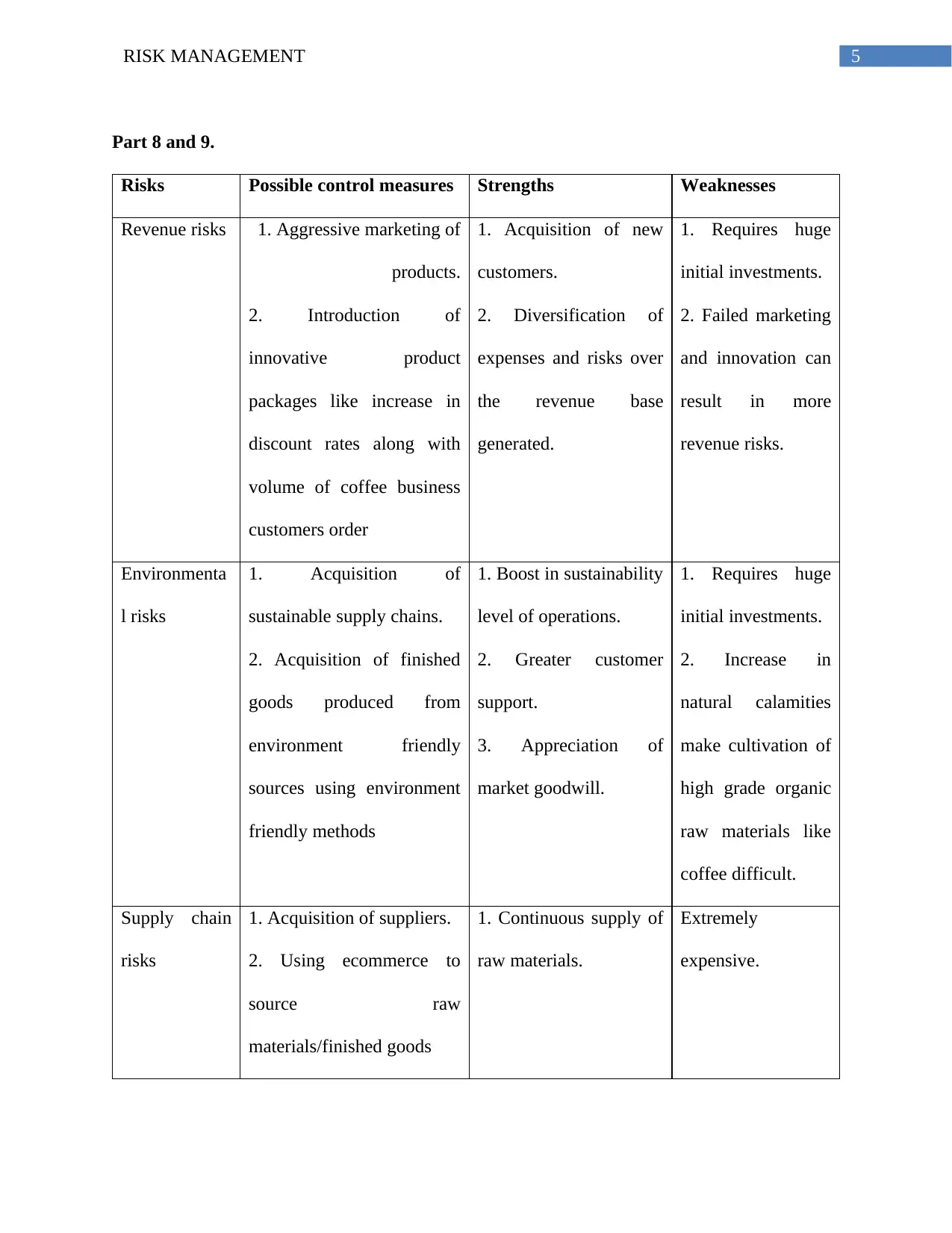
5RISK MANAGEMENT
Part 8 and 9.
Risks Possible control measures Strengths Weaknesses
Revenue risks 1. Aggressive marketing of
products.
2. Introduction of
innovative product
packages like increase in
discount rates along with
volume of coffee business
customers order
1. Acquisition of new
customers.
2. Diversification of
expenses and risks over
the revenue base
generated.
1. Requires huge
initial investments.
2. Failed marketing
and innovation can
result in more
revenue risks.
Environmenta
l risks
1. Acquisition of
sustainable supply chains.
2. Acquisition of finished
goods produced from
environment friendly
sources using environment
friendly methods
1. Boost in sustainability
level of operations.
2. Greater customer
support.
3. Appreciation of
market goodwill.
1. Requires huge
initial investments.
2. Increase in
natural calamities
make cultivation of
high grade organic
raw materials like
coffee difficult.
Supply chain
risks
1. Acquisition of suppliers.
2. Using ecommerce to
source raw
materials/finished goods
1. Continuous supply of
raw materials.
Extremely
expensive.
Part 8 and 9.
Risks Possible control measures Strengths Weaknesses
Revenue risks 1. Aggressive marketing of
products.
2. Introduction of
innovative product
packages like increase in
discount rates along with
volume of coffee business
customers order
1. Acquisition of new
customers.
2. Diversification of
expenses and risks over
the revenue base
generated.
1. Requires huge
initial investments.
2. Failed marketing
and innovation can
result in more
revenue risks.
Environmenta
l risks
1. Acquisition of
sustainable supply chains.
2. Acquisition of finished
goods produced from
environment friendly
sources using environment
friendly methods
1. Boost in sustainability
level of operations.
2. Greater customer
support.
3. Appreciation of
market goodwill.
1. Requires huge
initial investments.
2. Increase in
natural calamities
make cultivation of
high grade organic
raw materials like
coffee difficult.
Supply chain
risks
1. Acquisition of suppliers.
2. Using ecommerce to
source raw
materials/finished goods
1. Continuous supply of
raw materials.
Extremely
expensive.
⊘ This is a preview!⊘
Do you want full access?
Subscribe today to unlock all pages.

Trusted by 1+ million students worldwide
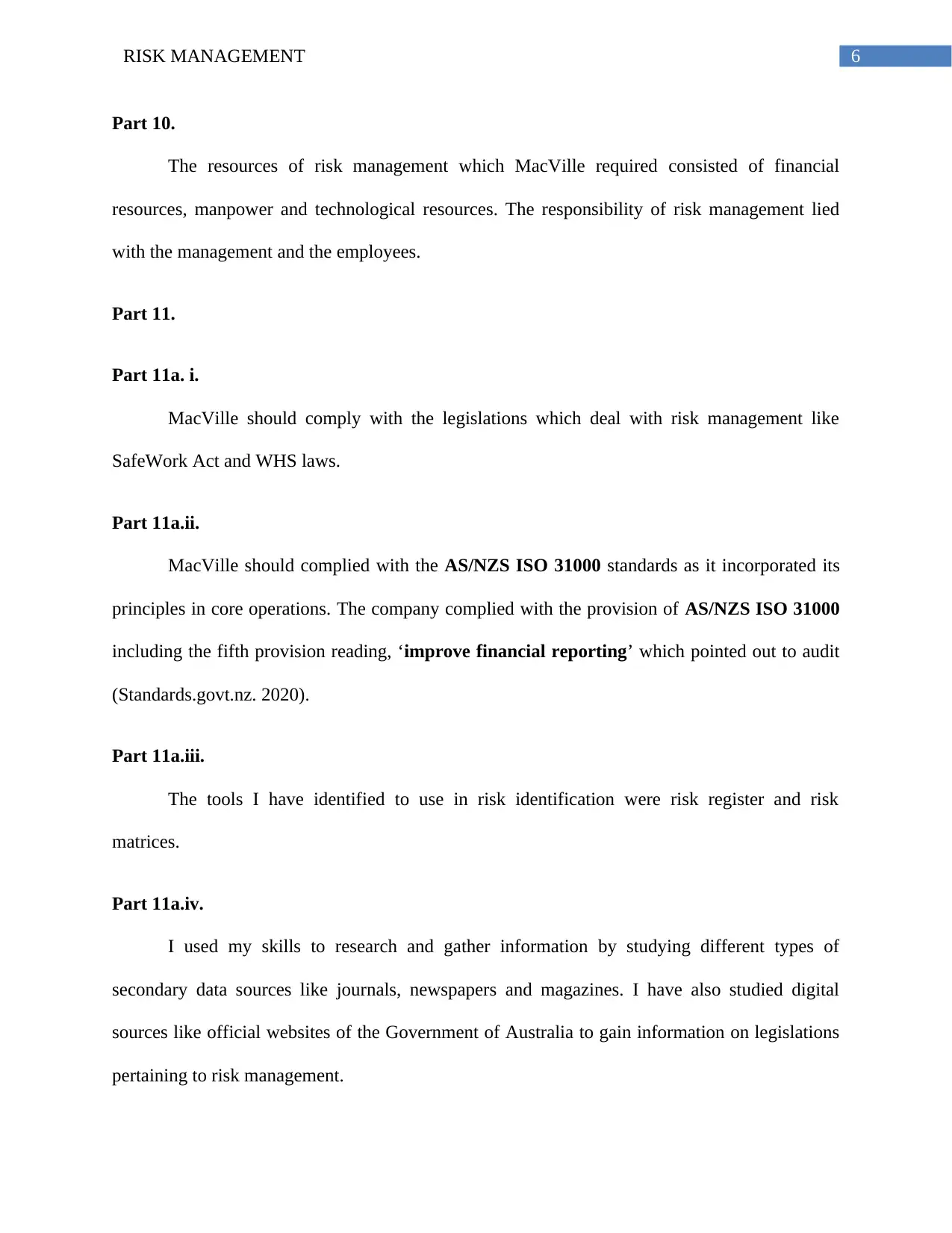
6RISK MANAGEMENT
Part 10.
The resources of risk management which MacVille required consisted of financial
resources, manpower and technological resources. The responsibility of risk management lied
with the management and the employees.
Part 11.
Part 11a. i.
MacVille should comply with the legislations which deal with risk management like
SafeWork Act and WHS laws.
Part 11a.ii.
MacVille should complied with the AS/NZS ISO 31000 standards as it incorporated its
principles in core operations. The company complied with the provision of AS/NZS ISO 31000
including the fifth provision reading, ‘improve financial reporting’ which pointed out to audit
(Standards.govt.nz. 2020).
Part 11a.iii.
The tools I have identified to use in risk identification were risk register and risk
matrices.
Part 11a.iv.
I used my skills to research and gather information by studying different types of
secondary data sources like journals, newspapers and magazines. I have also studied digital
sources like official websites of the Government of Australia to gain information on legislations
pertaining to risk management.
Part 10.
The resources of risk management which MacVille required consisted of financial
resources, manpower and technological resources. The responsibility of risk management lied
with the management and the employees.
Part 11.
Part 11a. i.
MacVille should comply with the legislations which deal with risk management like
SafeWork Act and WHS laws.
Part 11a.ii.
MacVille should complied with the AS/NZS ISO 31000 standards as it incorporated its
principles in core operations. The company complied with the provision of AS/NZS ISO 31000
including the fifth provision reading, ‘improve financial reporting’ which pointed out to audit
(Standards.govt.nz. 2020).
Part 11a.iii.
The tools I have identified to use in risk identification were risk register and risk
matrices.
Part 11a.iv.
I used my skills to research and gather information by studying different types of
secondary data sources like journals, newspapers and magazines. I have also studied digital
sources like official websites of the Government of Australia to gain information on legislations
pertaining to risk management.
Paraphrase This Document
Need a fresh take? Get an instant paraphrase of this document with our AI Paraphraser
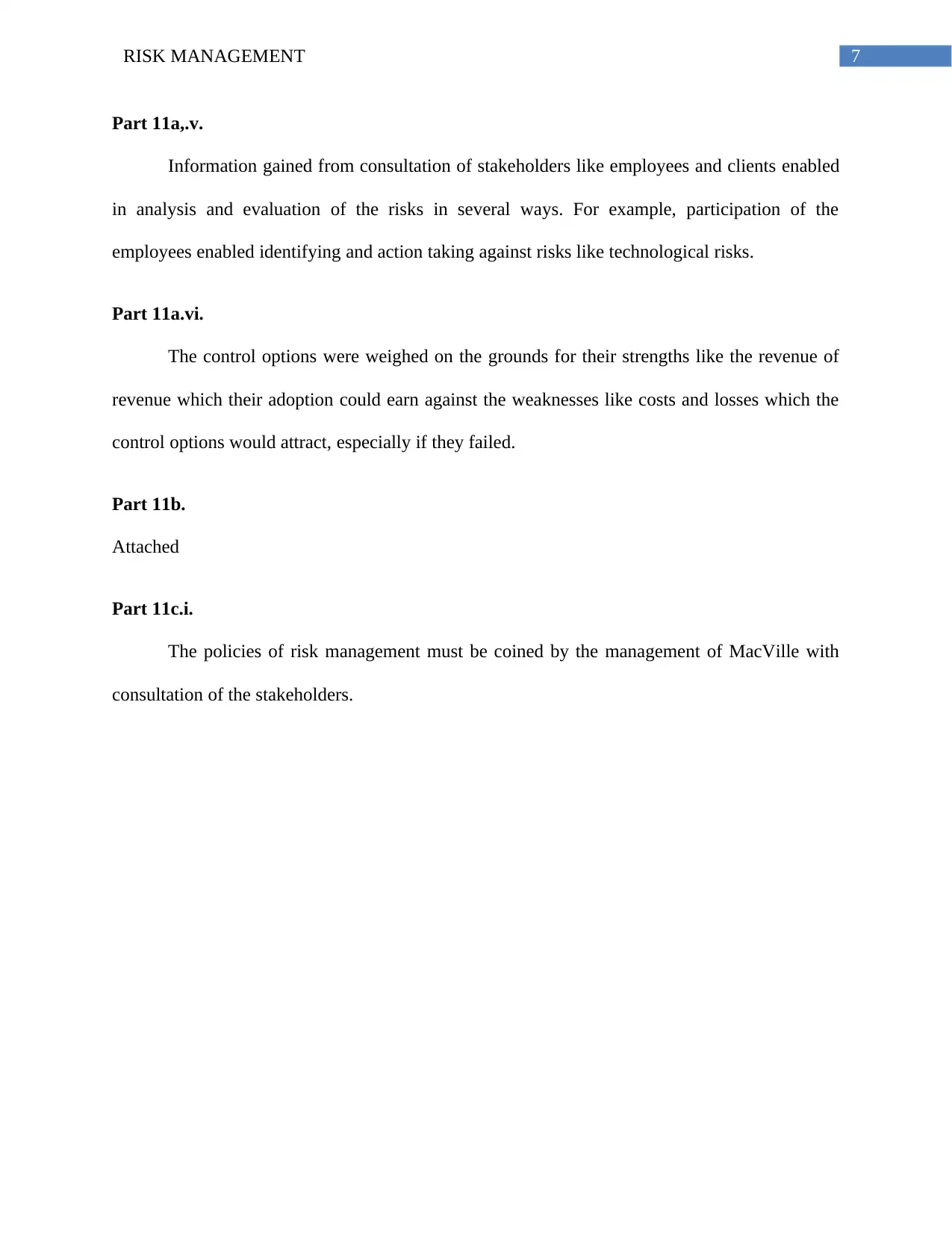
7RISK MANAGEMENT
Part 11a,.v.
Information gained from consultation of stakeholders like employees and clients enabled
in analysis and evaluation of the risks in several ways. For example, participation of the
employees enabled identifying and action taking against risks like technological risks.
Part 11a.vi.
The control options were weighed on the grounds for their strengths like the revenue of
revenue which their adoption could earn against the weaknesses like costs and losses which the
control options would attract, especially if they failed.
Part 11b.
Attached
Part 11c.i.
The policies of risk management must be coined by the management of MacVille with
consultation of the stakeholders.
Part 11a,.v.
Information gained from consultation of stakeholders like employees and clients enabled
in analysis and evaluation of the risks in several ways. For example, participation of the
employees enabled identifying and action taking against risks like technological risks.
Part 11a.vi.
The control options were weighed on the grounds for their strengths like the revenue of
revenue which their adoption could earn against the weaknesses like costs and losses which the
control options would attract, especially if they failed.
Part 11b.
Attached
Part 11c.i.
The policies of risk management must be coined by the management of MacVille with
consultation of the stakeholders.
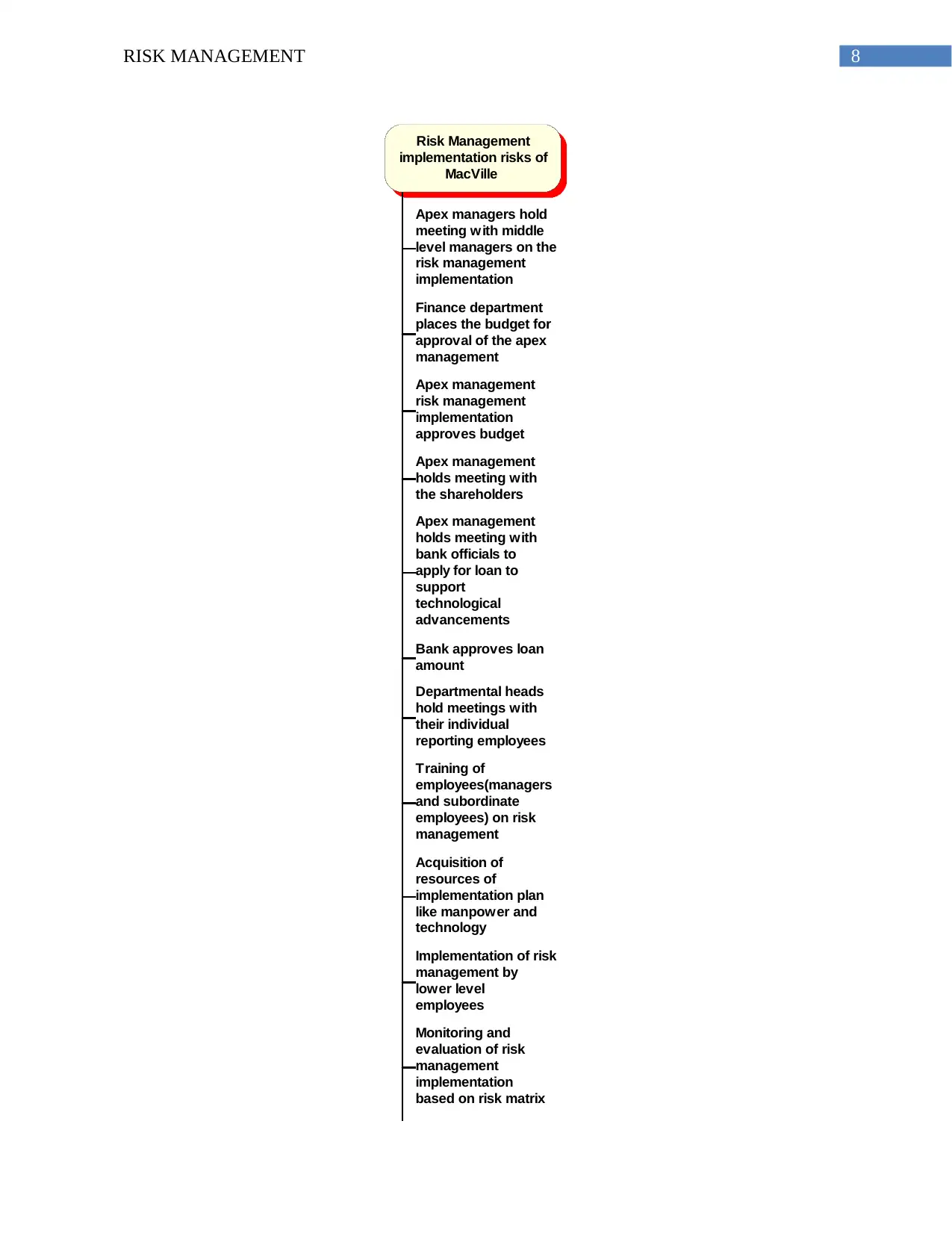
8RISK MANAGEMENT
Risk Management
implementation risks of
MacVille
Apex managers hold
meeting with middle
level managers on the
risk management
implementation
Finance department
places the budget for
approval of the apex
management
Apex management
risk management
implementation
approves budget
Apex management
holds meeting with
the shareholders
Apex management
holds meeting with
bank officials to
apply for loan to
support
technological
advancements
Bank approves loan
amount
Departmental heads
hold meetings with
their individual
reporting employees
Training of
employees(managers
and subordinate
employees) on risk
management
Acquisition of
resources of
implementation plan
like manpower and
technology
Implementation of risk
management by
lower level
employees
Monitoring and
evaluation of risk
management
implementation
based on risk matrix
Further action and
decision making
Risk Management
implementation risks of
MacVille
Apex managers hold
meeting with middle
level managers on the
risk management
implementation
Finance department
places the budget for
approval of the apex
management
Apex management
risk management
implementation
approves budget
Apex management
holds meeting with
the shareholders
Apex management
holds meeting with
bank officials to
apply for loan to
support
technological
advancements
Bank approves loan
amount
Departmental heads
hold meetings with
their individual
reporting employees
Training of
employees(managers
and subordinate
employees) on risk
management
Acquisition of
resources of
implementation plan
like manpower and
technology
Implementation of risk
management by
lower level
employees
Monitoring and
evaluation of risk
management
implementation
based on risk matrix
Further action and
decision making
⊘ This is a preview!⊘
Do you want full access?
Subscribe today to unlock all pages.

Trusted by 1+ million students worldwide
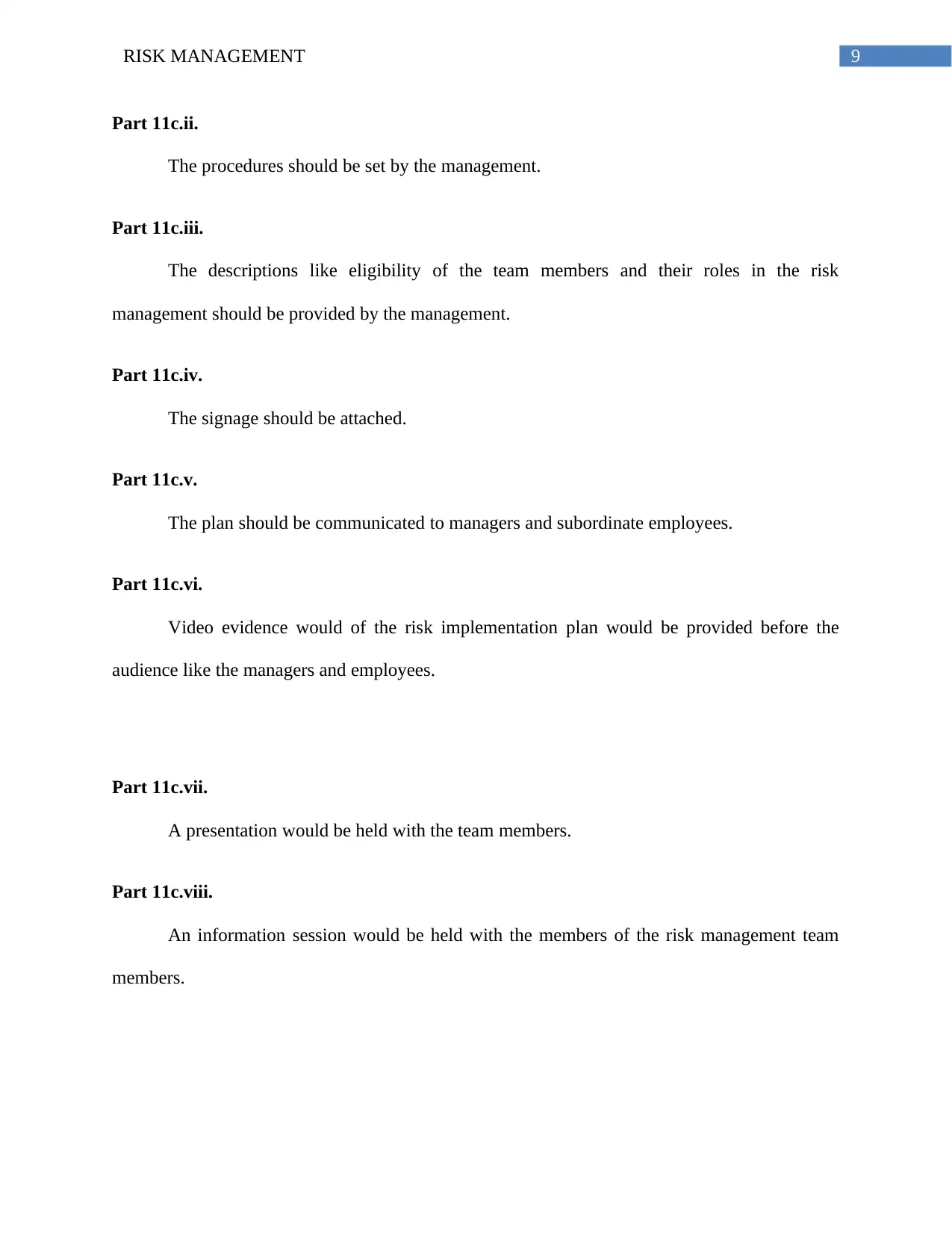
9RISK MANAGEMENT
Part 11c.ii.
The procedures should be set by the management.
Part 11c.iii.
The descriptions like eligibility of the team members and their roles in the risk
management should be provided by the management.
Part 11c.iv.
The signage should be attached.
Part 11c.v.
The plan should be communicated to managers and subordinate employees.
Part 11c.vi.
Video evidence would of the risk implementation plan would be provided before the
audience like the managers and employees.
Part 11c.vii.
A presentation would be held with the team members.
Part 11c.viii.
An information session would be held with the members of the risk management team
members.
Part 11c.ii.
The procedures should be set by the management.
Part 11c.iii.
The descriptions like eligibility of the team members and their roles in the risk
management should be provided by the management.
Part 11c.iv.
The signage should be attached.
Part 11c.v.
The plan should be communicated to managers and subordinate employees.
Part 11c.vi.
Video evidence would of the risk implementation plan would be provided before the
audience like the managers and employees.
Part 11c.vii.
A presentation would be held with the team members.
Part 11c.viii.
An information session would be held with the members of the risk management team
members.
Paraphrase This Document
Need a fresh take? Get an instant paraphrase of this document with our AI Paraphraser
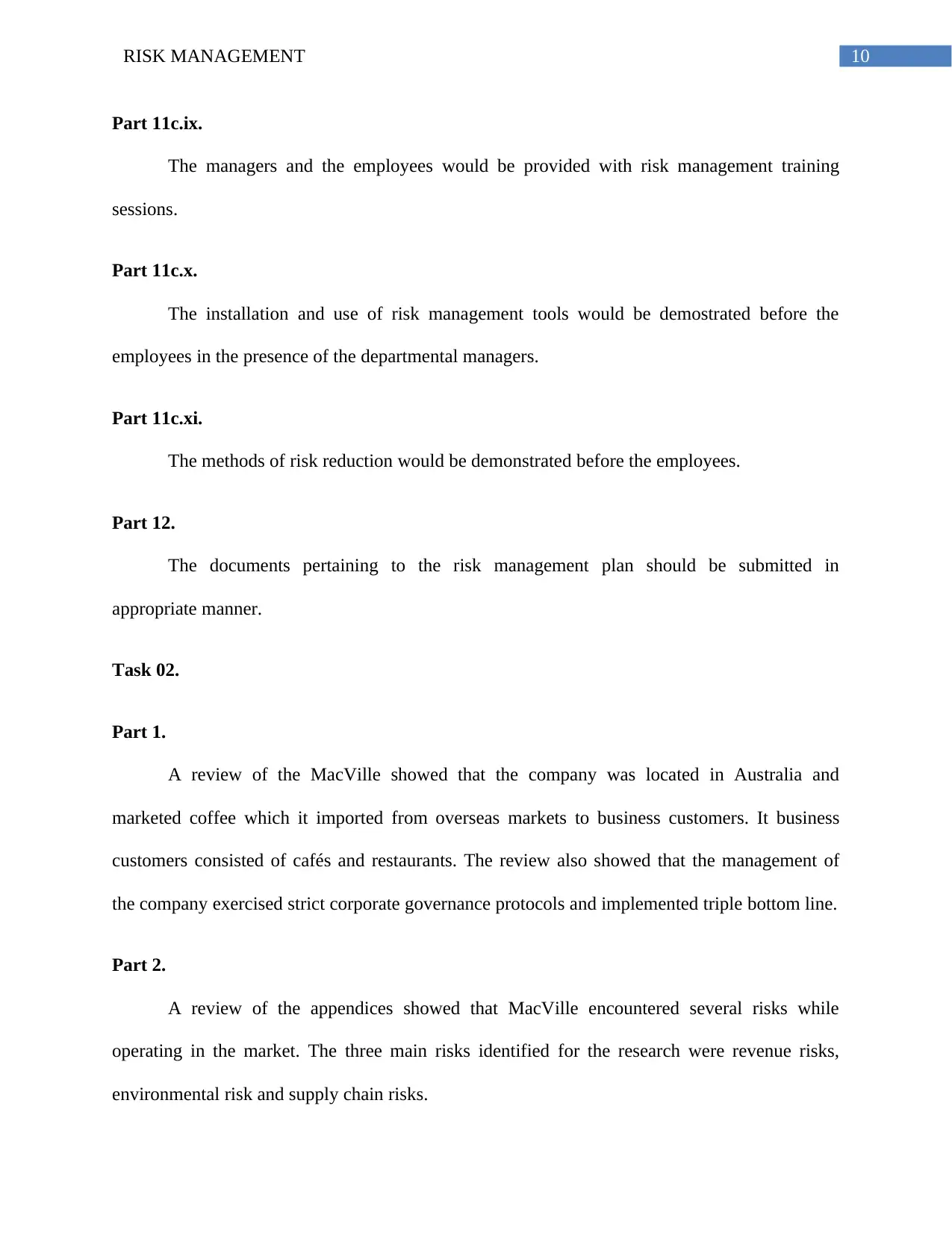
10RISK MANAGEMENT
Part 11c.ix.
The managers and the employees would be provided with risk management training
sessions.
Part 11c.x.
The installation and use of risk management tools would be demostrated before the
employees in the presence of the departmental managers.
Part 11c.xi.
The methods of risk reduction would be demonstrated before the employees.
Part 12.
The documents pertaining to the risk management plan should be submitted in
appropriate manner.
Task 02.
Part 1.
A review of the MacVille showed that the company was located in Australia and
marketed coffee which it imported from overseas markets to business customers. It business
customers consisted of cafés and restaurants. The review also showed that the management of
the company exercised strict corporate governance protocols and implemented triple bottom line.
Part 2.
A review of the appendices showed that MacVille encountered several risks while
operating in the market. The three main risks identified for the research were revenue risks,
environmental risk and supply chain risks.
Part 11c.ix.
The managers and the employees would be provided with risk management training
sessions.
Part 11c.x.
The installation and use of risk management tools would be demostrated before the
employees in the presence of the departmental managers.
Part 11c.xi.
The methods of risk reduction would be demonstrated before the employees.
Part 12.
The documents pertaining to the risk management plan should be submitted in
appropriate manner.
Task 02.
Part 1.
A review of the MacVille showed that the company was located in Australia and
marketed coffee which it imported from overseas markets to business customers. It business
customers consisted of cafés and restaurants. The review also showed that the management of
the company exercised strict corporate governance protocols and implemented triple bottom line.
Part 2.
A review of the appendices showed that MacVille encountered several risks while
operating in the market. The three main risks identified for the research were revenue risks,
environmental risk and supply chain risks.
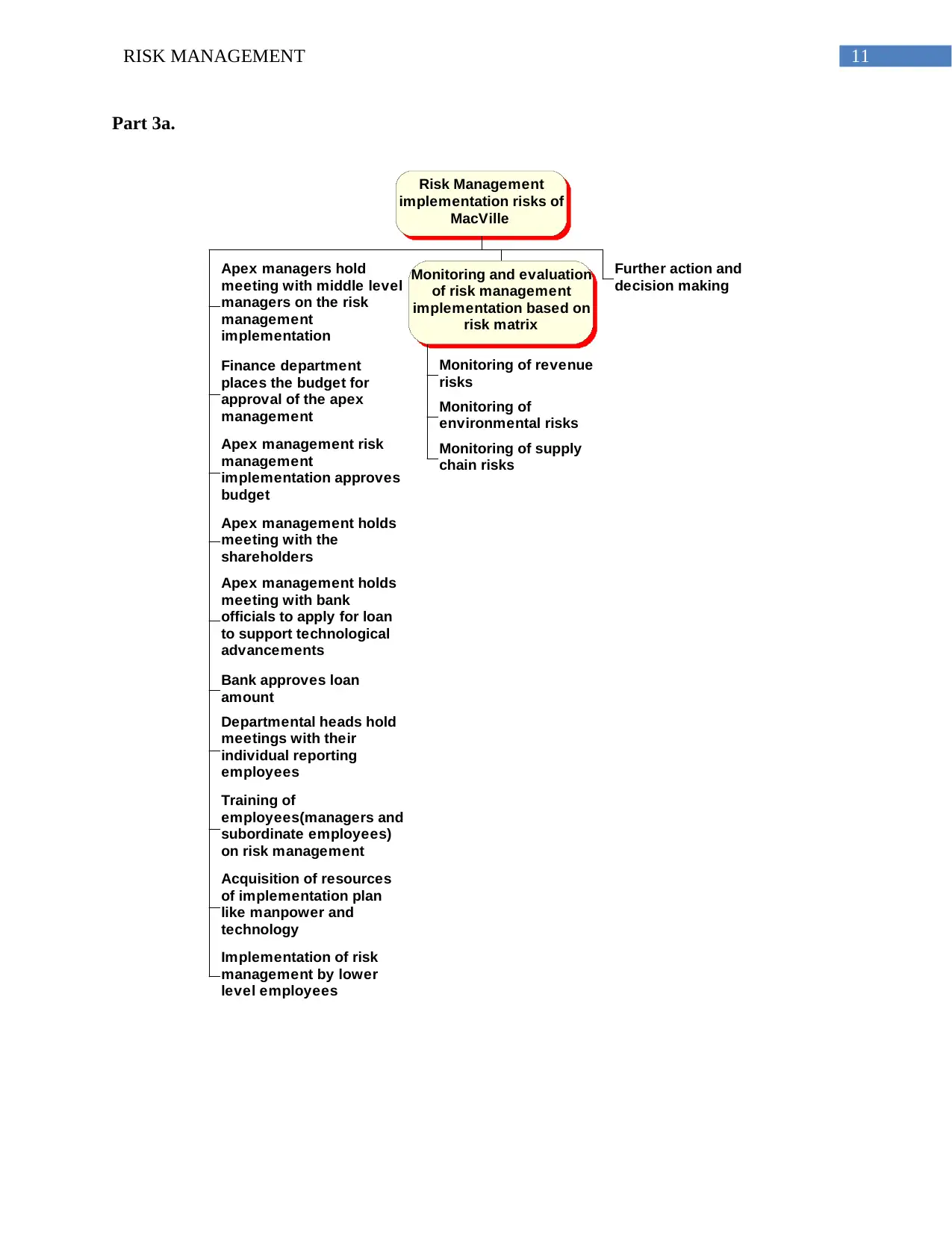
11RISK MANAGEMENT
Part 3a.
Risk Management
implementation risks of
MacVille
Apex managers hold
meeting with middle level
managers on the risk
management
implementation
Finance department
places the budget for
approval of the apex
management
Apex management risk
management
implementation approves
budget
Apex management holds
meeting with the
shareholders
Apex management holds
meeting with bank
officials to apply for loan
to support technological
advancements
Bank approves loan
amount
Departmental heads hold
meetings with their
individual reporting
employees
Training of
employees(managers and
subordinate employees)
on risk management
Acquisition of resources
of implementation plan
like manpower and
technology
Implementation of risk
management by lower
level employees
Monitoring and evaluation
of risk management
implementation based on
risk matrix
Monitoring of revenue
risks
Monitoring of
environmental risks
Monitoring of supply
chain risks
Further action and
decision making
Part 3a.
Risk Management
implementation risks of
MacVille
Apex managers hold
meeting with middle level
managers on the risk
management
implementation
Finance department
places the budget for
approval of the apex
management
Apex management risk
management
implementation approves
budget
Apex management holds
meeting with the
shareholders
Apex management holds
meeting with bank
officials to apply for loan
to support technological
advancements
Bank approves loan
amount
Departmental heads hold
meetings with their
individual reporting
employees
Training of
employees(managers and
subordinate employees)
on risk management
Acquisition of resources
of implementation plan
like manpower and
technology
Implementation of risk
management by lower
level employees
Monitoring and evaluation
of risk management
implementation based on
risk matrix
Monitoring of revenue
risks
Monitoring of
environmental risks
Monitoring of supply
chain risks
Further action and
decision making
⊘ This is a preview!⊘
Do you want full access?
Subscribe today to unlock all pages.

Trusted by 1+ million students worldwide
1 out of 17
Related Documents
Your All-in-One AI-Powered Toolkit for Academic Success.
+13062052269
info@desklib.com
Available 24*7 on WhatsApp / Email
![[object Object]](/_next/static/media/star-bottom.7253800d.svg)
Unlock your academic potential
Copyright © 2020–2025 A2Z Services. All Rights Reserved. Developed and managed by ZUCOL.




